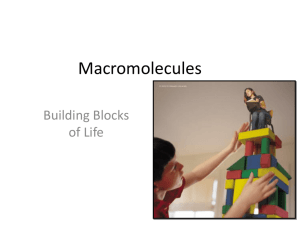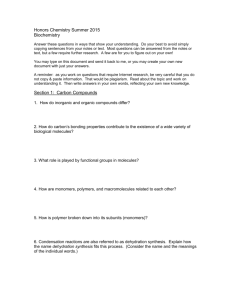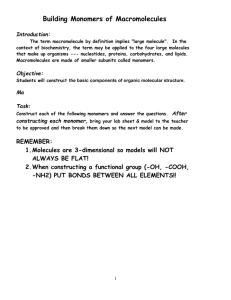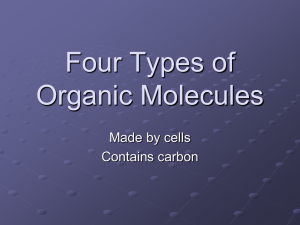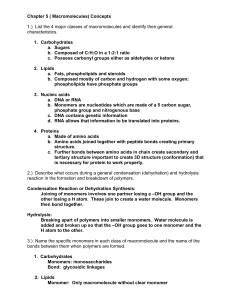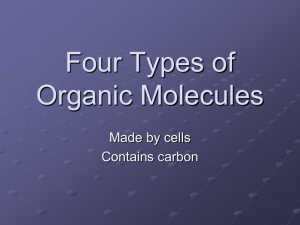Life`s Macromolecules
advertisement
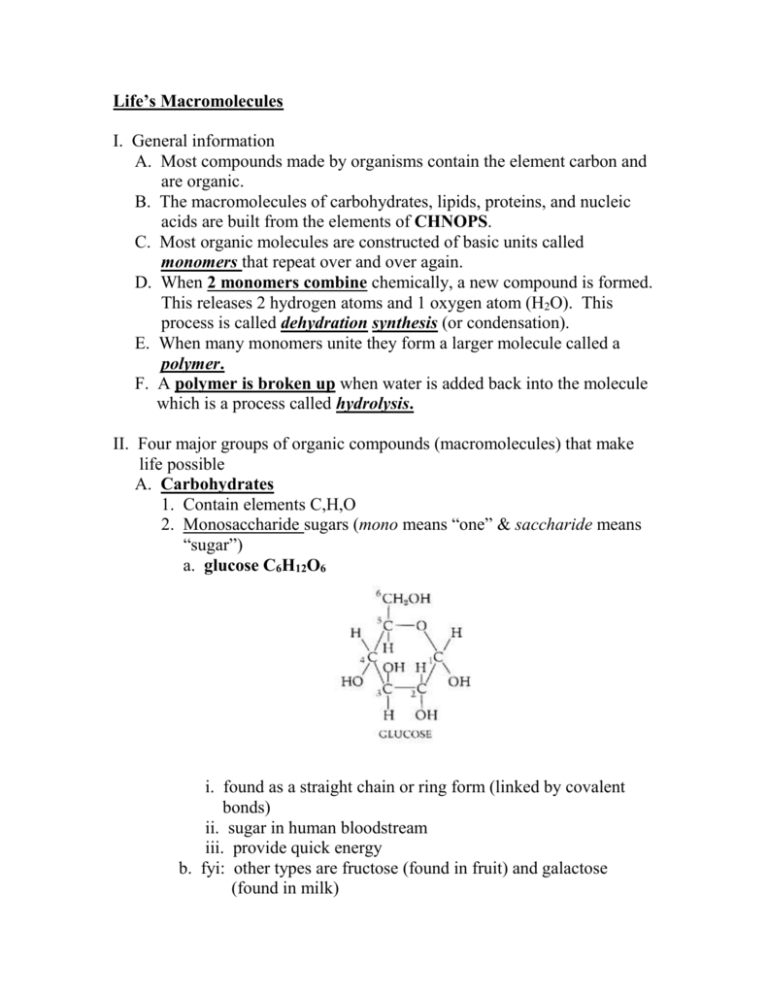
Life’s Macromolecules I. General information A. Most compounds made by organisms contain the element carbon and are organic. B. The macromolecules of carbohydrates, lipids, proteins, and nucleic acids are built from the elements of CHNOPS. C. Most organic molecules are constructed of basic units called monomers that repeat over and over again. D. When 2 monomers combine chemically, a new compound is formed. This releases 2 hydrogen atoms and 1 oxygen atom (H2O). This process is called dehydration synthesis (or condensation). E. When many monomers unite they form a larger molecule called a polymer. F. A polymer is broken up when water is added back into the molecule which is a process called hydrolysis. II. Four major groups of organic compounds (macromolecules) that make life possible A. Carbohydrates 1. Contain elements C,H,O 2. Monosaccharide sugars (mono means “one” & saccharide means “sugar”) a. glucose C6H12O6 i. found as a straight chain or ring form (linked by covalent bonds) ii. sugar in human bloodstream iii. provide quick energy b. fyi: other types are fructose (found in fruit) and galactose (found in milk) 3. Disaccharide sugars-link 2 monosaccharides together by dehydration synthesis a. fyi: types are sucrose (table sugar), maltose (found in malted milk balls), and lactose (found in milk) 4. Polysaccharide sugars-made of 100’s to 1000’s of glucose monomer units linked by dehydration synthesis a. starch i. main energy storage for plants ii. found in cereals, pastas, rice b. fyi: other types are glycogen, cellulose, & chitin 5. general sources of carbohydrates-grains, rice, breads, fruits, vegetables, potatoes, sweets (60 % of daily calorie intake) B. Lipids 1. contain monomer units of 1 molecule glycerol linked to 3 fatty acids (called a triglyceride) through dehydration synthesis (makes water) 2. contain C,H,O but have less oxygen than carbohydrates 3. saturated fats-animal fats (contain single bonds)-solids-ex. butter 4. unsaturated fats- oils from plants (contain double bonds)-liquidsex. Olive oil 5. cholesterol-lipid found in animal foods i. helps build cell membranes 6. provide long term energy storage, insulation, and protection 7. general sources of lipids-fats,oils, waxes, meat, fish, poultry, dairy products (30 % of daily calorie intake) C. Proteins 1. made from monomer unit of amino acids linked by dehydration synthesis (forms water) 2. the R group varies in each amino acid which results in 20 different amino acids 3. when amino acids link together they remove water and form peptide bonds 4. when a long chain of amino acids are linked together it is referred to as a polypeptide 5. when 2 or more polypeptides join together (by twisting and folding) a protein is made 6. found in hair , nails, muscle, and form enzymes 7. general sources of proteins-meats, peanuts, beans, milk, eggs, fish (10 % of daily calorie intake) D. Nucleic Acids 1. DNA (Deoxyribonucleic Acid) a. codes and stores all genetic material of cell regarding replication and the order in which amino acids should be joined to form a protein. b. made of monomers called nucleotides (made of a phosphate group, nitrogen base, and a 5-carbon sugar (deoxyribose) ) c. shape of a spiral helix or twisted ladder (double helix) 2. RNA (Ribonucleic Acid) a. involved with forming proteins b. made of monomers called nucleotides (made of a phosphate group, nitrogen base, and a 5-carbon sugar (ribose) ) c. single stranded molecule (types are mRNA, tRNA, & rRNA)


